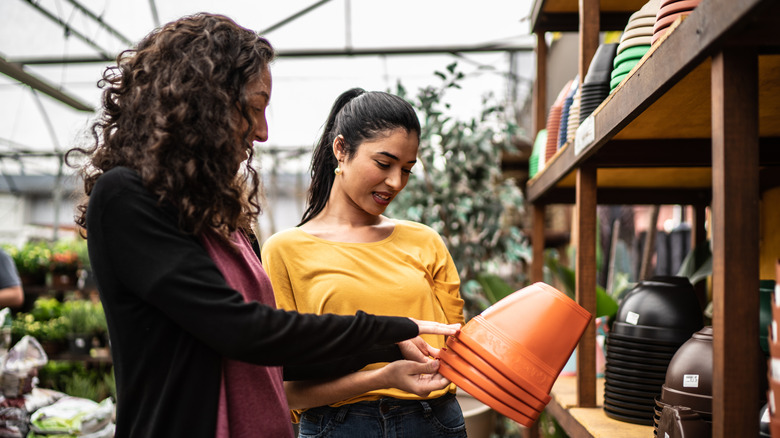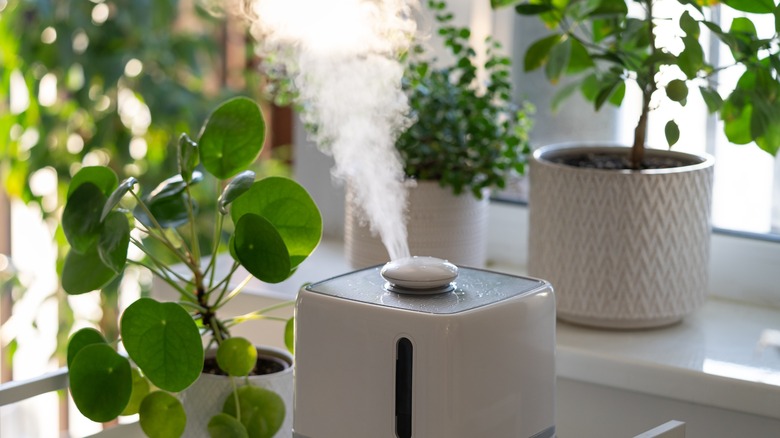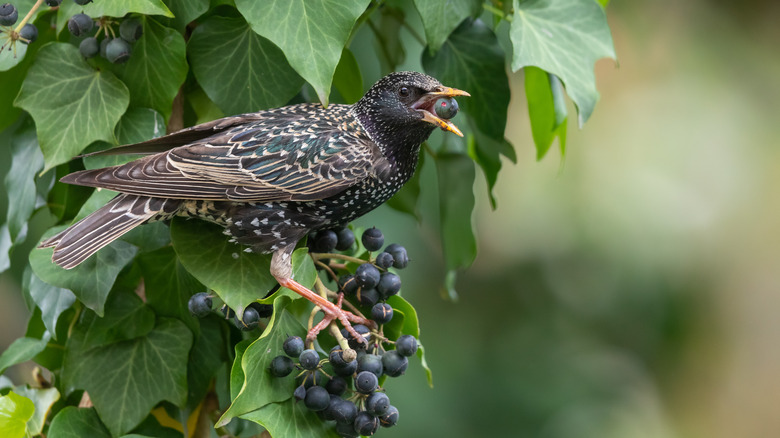12 Issues To Know About Before Growing English Ivy
English ivy is known to be a hearty and versatile plant that can be found inside your home or outside in the garden. It's a fan favorite for its unique look with wild, winding tendrils and heart-shaped leaves. This romantic plant evokes the feeling of the English countryside and practically transports you inside a Jane Austen novel. Aside from looking pretty, though, English ivy has some practical uses too. Some claim its quick growth and stable roots make it a prime choice to secure a hillside against erosion, and a NASA clean air study in 1989 showed that it is one of the best plants for indoor air purification.
English ivy owners live all around the world, cultivating it as a non-native species in their region. This has caused the plant to be controversial among homeowners, gardeners, and ecologists alike. With the right care and planning, though, there is absolutely a way to integrate English ivy into your home and have both you and your plant thrive. However, before you rush off to the store, there are some things you need to be aware of to decide whether this is the right choice for you. Here are 12 issues to know about before growing English ivy.
It won't thrive in a cold climate
English ivy is a relatively hearty plant, but that doesn't mean it will thrive in extreme temperatures. Anywhere from 50 to 70 degrees Fahrenheit is the sweet spot for ivy to remain healthy and growing. It prefers cooler temperatures, but if there is a heat wave or cold dip at night, don't worry, your ivy should remain strong throughout these changes. The problem arises when there is a sustained period of freezing weather, which will harm your plant.
If you live in a climate that faces tough temperatures year-round, avoid planting English ivy outside. You can still enjoy the plant by cultivating it in a pot that you bring inside once the seasons shift to winter. If you have ivy planted on a hillside or as a ground covering that you cannot transport, with proper preparation, you can protect it from freezing. By adding a 2- to 3-inch thick layer of mulch, you can preserve the soil's moisture and regulate temperature. This should give the plant the extra help it needs to make it through the winter. Otherwise, tend to the plant as usual (though you may want to think twice before using fertilizer).
It's an invasive species
English ivy is native to, well, England, as well as most of Europe and parts of Northern Africa and Western Asia. It came to the Americas in the 1700s and spread to many places around the world. The main issue with this ivy is that it grows quickly in every direction, across forests and up trees, completely overtaking everything in its path. It overwhelms other ground coverings and vegetation, creating less biodiversity and killing native plants that ecosystems may need to survive. It can climb up tree trunks to the canopy, eventually growing to almost completely engulf the tree. This makes it difficult for the tree to complete the photosynthesis it needs to survive.
The best way to prevent this from happening is to not plant English ivy in the first place. However, if you think this is the best choice of ground covering for you or if you bought a house that already has it, it is important to take proper care so that it does not overpower the rest of the plants on your property. Trimming your ivy regularly will keep it from dominating your garden and causing harm as a non-native species. If you still want all the benefits without the hassle of committing to a landscaping maintenance routine, you can always plant your ivy in pots to keep it from spreading wildly.
The sap can cause an allergic reaction
While not as well-known an irritant as poison ivy, oak, or sumac, the sap from English ivy has been reported to cause an allergic reaction in some people called contact dermatitis. This is a skin rash caused by contact with an irritating substance, and although it isn't life-threatening, it is very, very itchy and will cause a substantial amount of discomfort.
To avoid harming your skin while trying to maintain your ivy, use protective gardening gloves that extend past your wrists to ensure that no irritants come in contact with your skin. If you have a large patch of outdoor ivy that you want to remove, consider using a professional lawn care service whose gardeners are equipped to tackle such projects.
Despite the possibility of an allergic reaction, remember that plenty of people have English ivy plants with no problem. But if you are someone who is prone to allergic reactions or has a history of ivy-induced rashes, consider whether this is the right choice for you.
Growth can become leggy without proper light
We all know the frustration when your plant is growing, but the new growth only has long and spindly stems with just a few leaves. English ivy is a houseplant especially prone to becoming leggy because the stems of the vines are naturally thin and long. They can easily cross the line between delicate and weak if they don't have the proper environment to thrive.
The most common culprit is a lack of proper light. Of course, if your ivy is outside, you can't control the weather, but choosing the right placement for your indoor plant is critical. Moderate light is the best option, but it will also tolerate bright light conditions. In most seasons, indoor English ivy wants indirect light, and in the wintertime, it can take a more substantial amount of direct sunlight. You will want to rotate the plant routinely so that each side receives equal amounts of light. If you're growing it outdoors, English ivy prefers low light conditions.
Spider mites love it
With any houseplant, you run the risk of a pest infestation, but spider mites in particular love English ivy. These little bugs might be as small as a period mark, but they can do some serious damage to your plant if they aren't caught and eliminated quickly. Whether the bug was already present when you received the ivy or it hopped over from another infested houseplant, they multiply quickly and can sometimes be hard to spot because they hide under protective webbing. While these pests don't cause any harm to humans, they feed by puncturing the plant cells and absorbing the nutrients, which will cause your plant to quickly turn yellow and start dropping leaves, then eventually die.
Facing a pest or two is inevitable as a plant owner, but the important thing is to act fast. There are plenty of easy ways to get rid of spider mites, including spraying insecticidal soap over your plants or creating a DIY solution of 1 quart of water, 1 teaspoon of lemon-scented dish soap, and 1/2 ounce of rosemary essential oil to create an all-natural pesticide spray. Another easy option is simply to rinse off your plant in the shower, sink, or outside with a hose. No matter what method you choose, make sure to pay special attention to the underside of the leaves, which is where the mites typically live.
Soil acidity is critical
Because English ivy has a reputation for growing anywhere and everywhere outdoors, you might think that the type of soil doesn't matter. But in order for your houseplant to properly grow, you will want to make sure the dirt is slightly on the acidic side, with the ideal pH range being between 5.5 and 6.5. Once your soil gets more alkaline than this, the plant will struggle to absorb the nutrients, which will inhibit growth.
If you are repotting your plant, you have the luxury of choosing the soil, but if you are inheriting a plant or you think that your soil's pH might be different than what you previously thought, you should first test the pH of your soil. If your soil is too alkaline, you can use an acidic fertilizer to alter the pH. You can also add a bit of sulfur to your plants, which is highly acidifying. There's no need to be a chemist, as you can easily buy plant sulfur at hardware stores. Bonafide sulfur from Ace Hardware, for example, is a multipurpose product that will balance the acidity of the soil while also acting as a fungicide to effectively prevent and control common diseases, and it even helps eliminate pests.
Too big of a pot will kill it
Choosing the right pot size for your plant is a bit of a Goldilocks situation. It's common knowledge that too small of a pot will prevent growth because the roots have nowhere to spread, but too big of a pot will also harm your plant. You might think that a bigger pot will provide your ivy with all the room it needs to grow, but you want to increase pot size gradually. If you have too big of a pot and an excess of dirt, the soil will retain more water and not fully dry out, becoming susceptible to root rot.
Root rot is the result of improper draining or overwatered soil. If the dirt is overly moist and never fully dries out in between waterings, the roots will begin to decay and prevent the plant from absorbing the oxygen and other nutrients it needs. You want to choose a pot that is 2 to 4 inches wider than the diameter of your plant. This will give it enough space to grow and spread its roots. Prioritizing a pot with the best drainage material is critical to the health of any plant. If you want something that fits your home's style, you can always put a well-draining pot inside of a decorative pot to have the best of both worlds.
It's toxic to animals
Curious cats and hungry dogs will go sniffing around almost anything, but if they ingest English ivy, it could mean a pricey trip to the vet, or worse. This ivy contains toxins (specifically saponins and polyacetylene compounds) that if ingested by animals or humans will cause allergic symptoms like vomiting and diarrhea.
Not growing English ivy on your property if you let your pets outdoors is an obvious solution, but if you already have a plant inside your home, there are a few things you can do to reduce the risk it poses to your furry friends. Placing the plant on a high shelf is a simple solution if you have a dog, but cats are notorious climbers. You can always put the plant in a room where your pet doesn't go or use a greenhouse to keep the plant enclosed. If you can't change the location of the plant, you can create a DIY repellent by mixing lemon juice with water and spraying it on your plant. The sour taste and smell will make it an unappealing option for your animals while causing no harm to the plant.
It needs a humid environment
Ivy thrives in a cool, damp environment and needs a little humidity in the air. Although English ivy can withstand a variety of temperatures, indoor ivy often faces too dry of an environment, especially when there is a heating and dehumidifying system in use. If you notice wilting or curling leaves and stems that are crisp and browning, a lack of humidity can be to blame.
To restore moisture to the air around your plant, you can put a tray with pebbles and water underneath the plant. As the water evaporates, it will create a more humid microclimate around the plant. However, it is important to make sure that the plant itself stays dry and isn't in contact with the standing water. Adding a humidifier to your home is the simplest way to add more moisture into the air. This will benefit your plants as well as your skin, especially during winter months. You can also try grouping plants together. As the plants develop, they will naturally raise the humidity level, creating a little humidity island that will benefit your ivy.
Direct light can cause burnt leaves
If an ivy plant is placed near a window or a location that receives long hours of direct light, you might start to notice some brown spots appearing on the leaves. While brown spots on leaves can be caused by many things, the spots alongside the symptom of crispy edges should raise the alarm that your plant might be getting sunburnt. If the ivy is outside and cannot be moved, all you can do is hope for a cloudy day.
For indoor English ivy plants, however, there are some easy solutions to get your plant back to good health. While you can't slather some sunscreen onto a plant, you can move the plant to a different location with bright but indirect light. A safe bet is to move it a few feet away from south- or west-facing windows, which receive the most direct light. If you aren't sure if your plant is getting too much sun or if you can't move it, rotating the plant regularly will prevent it from getting hit with too much sun in one spot.
The leaves turn yellow from overwatering and underwatering
One of the biggest frustrations about plant care is that often the same symptoms are caused by many different problems, or even polar opposite problems. For example, ivy leaves turn yellow if you have both overwatered or underwatered your plant. Underwatering will cause your plants to shrivel up and will make it hard for the plant to absorb the necessary nutrients. If your plant is overwatered, this can lead to root rot or attract bugs that will feed on the ivy and eventually cause it to die.
Each ivy plant is different, and their watering needs change with the season and environmental factors, so the most foolproof way of making sure you are watering the correct amount is to test the soil with your finger or with a soil moisture meter. If you're unwilling to spring for a moisture meter, just stick your finger vertically down into the soil, since soil that can appear to be dry on the top later could still be retaining a lot of moisture underneath. For English ivy, you want to wait until the soil is dried out about 25 to 50% of the way down before watering it again. Keep an eye on the drainage tray of the plant and discard any excess water as soon as you see it to keep your plant happy and properly hydrated.
It provides shelter for wildlife
This might be considered a benefit to you if you love having little critters call your yard home, but before you make the decision to plant ivy, it is important to know that the thick roots provide an alluring home to snakes, rodents, and birds. The ivy creates a dense cover for these creatures to live underneath, providing protection from the elements and other predators. Burrowing animals often find their way underneath the ivy as well.
If the ivy is in an area you don't typically frequent, then this might not be an issue for you, but if you have it located near your house or if you see it begin to grow up onto your roof, you might want to think whether this is the right choice for your home. The best way to prevent animals from taking up home in your ivy is to keep it trimmed, which encourages new growth while never letting it get too thick. Thick, wild ivy typically attracts animals, since it provides the best protection.












